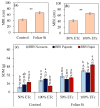Foliar Silicon Alleviates Water Deficit in Cowpea by Enhancing Nutrient Uptake, Proline Accumulation, and Antioxidant Activity
- PMID: 40284130
- PMCID: PMC12030621
- DOI: 10.3390/plants14081241
Foliar Silicon Alleviates Water Deficit in Cowpea by Enhancing Nutrient Uptake, Proline Accumulation, and Antioxidant Activity
Abstract
Silicon has emerged as a beneficial element in mitigating water deficit in various crops, although the underlying mechanisms still require further investigation. This study evaluated the foliar content of nutrients (N, P, K, and Ca) and proline, antioxidant activity, growth, water use efficiency, and yield of cowpea cultivars subjected to two irrigation depths (50% and 100% of crop evapotranspiration) and a foliar application of silicon (orthosilicic acid). A field experiment was conducted in a split-plot scheme using the randomized block design with four replications in a semi-arid region of northeastern Brazil. Silicon supplementation increased the foliar contents of N, P, and Ca; stimulated proline synthesis; and enhanced the activity of the SOD, CAT, and APX enzymes. These changes promoted growth, improved water use efficiency, and increased crop yield. The results indicate that foliar silicon application mitigates the effects of water deficit in cowpea plants while enhancing crop performance under full irrigation (100% of crop evapotranspiration), leading to higher yields even under favorable water conditions.
Keywords: Vigna unguiculata; abiotic stress; orthosilicic acid; water use efficiency; yield.
Conflict of interest statement
The authors declare no conflicts of interest.
Figures








References
-
- Abebe B.K., Alemayehu M.T. A review of the nutritional use of cowpea (Vigna unguiculata L. Walp) for human and animal diets. J. Agric. Food Res. 2022;10:100383. doi: 10.1016/j.jafr.2022.100383. - DOI
-
- Senthilkumar T., Ejilane E., Ramasamy M., Chittibomma K., Naorem C., Kumar R., Prasad S.V.B., Dhanalakshmi K., Chitra K. Exploring genetic divergence in cowpea: A comprehensive review. Asian J. Soil Sci. Plant Nutr. 2024;10:80–87. doi: 10.9734/ajsspn/2024/v10i2263. - DOI
-
- Silva J.D.A., Barros J.R.A., Silva E.G.F., Rocha M.D.M., Angelotti F. Cowpea: Prospecting for heat-tolerant genotypes. Agronomy. 2024;14:1969. doi: 10.3390/agronomy14091969. - DOI
-
- CONAB—Companhia Nacional de Abastecimento . Acompanhamento da Safra Brasileira de Grãos. CONAB; Russas, Brazil: 2024. [(accessed on 6 January 2025)]. Available online: https://www.conab.gov.br/info-agro/safras/graos/boletim-da-safra-de-graos.
LinkOut - more resources
Full Text Sources
Miscellaneous

